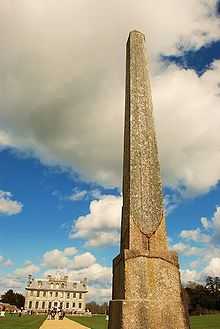Philae obelisk

The Philae obelisk is one of two obelisks found at Philae in Upper Egypt in 1815 and soon afterward acquired by William John Bankes. He noted two inscriptions on it, one in Egyptian hieroglyphs, the other in ancient Greek.[1] By comparing the two texts, although they were not translations of one another, Bankes believed that he recognised the names Ptolemy and Cleopatra in hieroglyphic characters. His identification was confirmed afterward by Thomas Young and Jean-François Champollion, and the obelisk was useful to Champollion in his eventual decipherment of Egyptian hieroglyphs.
The inscriptions record a petition by the Egyptian priests at Philae and the favourable response by Ptolemy VIII Euergetes and queens Cleopatra II and Cleopatra III. The documents are dated 118 or 117 BC.
During the 1820s, Bankes acquired the obelisk found at Philae and had it transported to his estate at Kingston Lacy in Dorset, England. The operation was carried out by the noted adventurer Giovanni Belzoni. The house now belongs to the National Trust and the obelisk still may be seen in the gardens.
The obelisk, in keeping with its bilingual nature and the "translation" metaphor of the Rosetta space mission, gives its name to the mission Philae robotic lander,[2] which arrived at the comet 67P/Churyumov–Gerasimenko on 6 August 2014[3] and landed on 12 November 2014.[4]
Bibliography
- Edwyn R. Bevan, The House of Ptolemy (London: Methuen, 1927) pp. 322–323 Textus
- E. A. Wallis Budge, The decrees of Memphis and Canopus (3 vols. London: Kegan Paul, 1904) vol. 1 pp. 139–159 Incomplete copy at Google Books
- Erik Iversen, Obelisks in exile. Vol. 2: The obelisks of Istanbul and England (Copenhagen: Gad, 1972) pp. 62–85
- T. G. H. James, Egyptian antiquities at Kingston Lacy, Dorset: the collection of William John Bankes. San Francisco: KMT Communications, 1993–94
- Stephanie Roberts, "The Real Cleopatra's Needle" in Ancient Egypt (Dec. 2007/Jan. 2008)
- Anne Sebba, The exiled collector: William Bankes and the making of an English country house. London: John Murray, 2004
References
- ↑ The Greek inscription has been referred to by scholars as "OGI 137–139; SB 8396; Lenger, C. Ord. Ptol., 51 f.; A. Bern., 19".
- ↑ Morris, Steven (23 October 2014). "Rosetta mission: Philae comet probe could unlock secrets of the universe". www.theguardian.com. Guardian News and Media Limited. Retrieved 14 November 2014.
- ↑ "Europe's Rosetta probe goes into orbit around distant comet". BBC News. 6 August 2014. Retrieved 6 August 2014.
- ↑ "Europe makes history with first ever comet landing". www.gov.uk. UK Space Agency. 12 November 2014. Retrieved 14 November 2014.